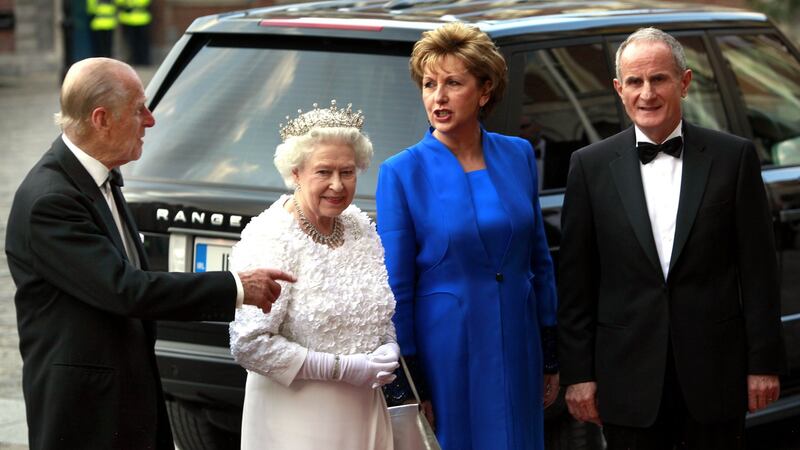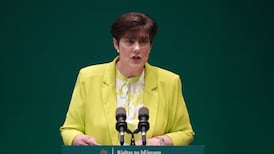Queen Elizabeth II won over an Irish audience in 2011 during her State visit to Ireland, with a nod to fallen heroes at the Garden of Remembrance in Dublin and exquisitely chosen words at Dublin Castle.
There, she rose to deliver a speech during a State banquet at Dublin Castle in 2011. Surprising her audience, it began, “A hUachtaráin agus a chairde”, having spent much time in practice to make sure she got it right.
Every word had been carefully chosen. During her speech to the gathering, she offered “my sincere thoughts and deep sympathy” to all those “who have suffered as a consequence of our troubled past”.
With Prince Philip by her side, and both in agreement that the visit was a mission to heal history, she went on: “With the benefit of historical hindsight we can all see things which we would wish had been done differently or not at all.”
She insisted on seeing and being seen – a phrase which haunted her protection teams. The short visit became the biggest royal security operation in history
The visit was a triumph. However, the first touch of Buckingham Palace was not always so sure, as recently declassified files revealed in The Secret Royals, Spying and the Crown, from Victoria to Diana show the journey the royals have made on Ireland.
In 1977 the queen celebrated her silver jubilee on the throne, and she intended to celebrate by criss-crossing the United Kingdom on a lengthy tour, including a trip to Northern Ireland in August – the height of the Protestant marching season.
Not visiting would have gifted the IRA with a propaganda victory; the queen had to be able to travel her realm unencumbered. She also had to do so visibly, rather than hiding out of sight behind armoured cars.
She insisted on seeing and being seen – a phrase which haunted her protection teams. The short visit became the biggest royal security operation in history, as the book reveals in detail.
The palace pondered what the queen would say to her subjects. Amid nationalist protests against her visit, delicate language was at a premium. Her private secretary, Martin Charteris, prepared a draft. It offered some suggestions that were so astonishingly out of touch with the politics of Northern Ireland that they horrified civil servants and would have inflamed the security situation in their own right.
In it, and the draft was circulated within senior ranks in the British government, Charteris would acknowledge that “some of my ancestors behaved less than well in this part of the world in centuries gone by”.
However, she would add the provocative qualification that their thinking was "understandable enough", since "implanting a British garrison" on the island of Ireland "made a certain sense" because foreign enemies wanted to use it as a "back door" against England.
If that was not enough of a red rag to nationalist opinion, the queen would go on to say: “What happened three, four hundred years ago is not our fault. It is our business but not our fault.”
The best the British intelligence services could do was identify a collective threat – and even then the chances of doing so were only fair to good
Northern Ireland, it went on, is now “home to people of mixed origin”, and this is an irreversible reality of the modern world. “It is not possible to say – it is not right to say – that one group of people belongs better than another,” the queen should say, wrote Charteris.
The thoughts for the speech had come from a mysterious “well-wisher”, he went on, saying he had passed them on officially from Buckingham Palace to the government with his personal endorsement. The draft speech, he wrote, “certainly seems to me to have quality”.
Sir Brian Cubbon, the senior civil servant in the Northern Ireland office, was less impressed. "Phew!", he scrawled before asking the palace for a meeting. Cubbon had been injured in an IRA bomb attack the year before, which had killed the British ambassador to Ireland, Sir Christopher Ewart-Biggs. He knew the realities on the ground better than many.
The dangers were very real in 1977 and the queen grew nervous as the visit approached. Charteris demanded the latest intelligence but was left underwhelmed. The threat was more oblique than direct. The best the British intelligence services could do was identify a collective threat – and even then the chances of doing so were only fair to good. Military intelligence listed a terrifying range of hazards, from a mortar attack on the royal yacht to a shooting from a nearby vessel, and from a terrorist carrying a concealed weapon to remotely detonated bombs. Royal security took part in an SAS training course on counterterrorism and hostage rescue.
Eventually, the Home Office bluntly asked: “Does she want to go or not?”
By now, the palace was jittery. Ronald Allison, the queen's press secretary, went off-script and raised security fears in writing with the man tasked to handle press coverage. Charteris was furious, insisting the correspondence be found and destroyed.

An editorial in The Irish Times argued that the queen’s visit should be called off, saying that there was already enough political tension in Northern Ireland during the summer months.
The visit went ahead but security was so tight that the queen had to stay overnight at sea and travel by helicopter – something she had always steadfastly avoided. She arrived to open the New University of Ulster at Coleraine, Co Derry, where police had found – and defused – two bombs just days earlier. Roy Mason, the Northern Ireland secretary, noted that the queen showed less enthusiasm. According to another British minister, she was terribly, terribly tense.
The presence of so many armoured troops turned it into what looked like a constitutionally dubious assertion of state authority
Speaking in front of television cameras in Coleraine, the queen gave a greatly toned-down version of what Charteris had suggested. “There is no place for old fears and attitudes born of history,” the queen told those watching, “nor for the attribution of blame for the past.” Someone must have heeded Cubbon’s horror.
Even so, a similar message prevailed. It was not the UK’s fault; people should move on. It was a far cry from her landmark speech 3½ decades later.
But then, the royal family has been on quite a journey themselves. In 1969, at the outbreak of the Troubles, the Irish government had quietly blocked Princess Margaret from travelling to Co Offaly on a family holiday. She was livid. When Princess Alexandra, the queen's younger cousin, was due to visit Northern Ireland on an icebreaking trip a few years later, the queen questioned whether it was safe.
Although the silver jubilee trip passed successfully, the presence of so many armoured troops turned it into what looked like a constitutionally dubious assertion of state authority. It further politicised the monarchy. Two years later, the IRA killed Lord Mountbatten. Prince Charles was devastated, writing angrily "it will take me a very long time to forgive these people". Princess Margaret was equally bitter, referring to the Irish as pigs when she visited Chicago shortly afterwards. A report very critical of the Irish police made its way to the palace.
Mountbatten's death brutally highlighted the royals' vulnerability. Six months later, she rode with a cousin through heavy mist on the Sandringham estate. Turned to her relative, she said: "I've been informed that the IRA have a new sort of sniper that sees through the mist." They rode on.
The Secret Royals: Spying and the Crown, from Victoria to Diana is published by Atlantic Books











